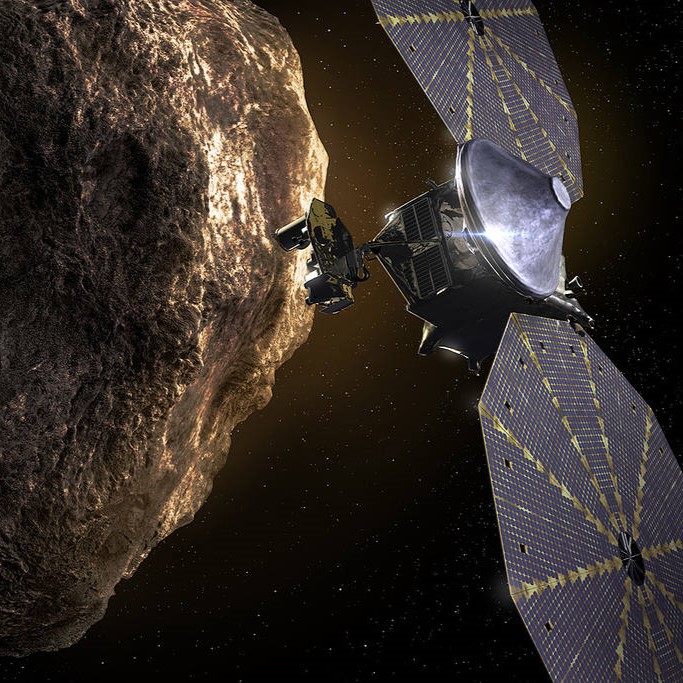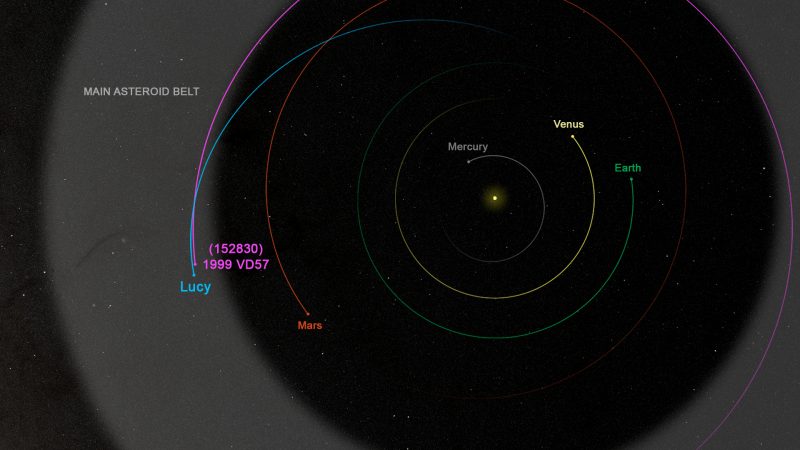
NASA’s Lucy spacecraft is in the midst of three Earth flybys that ultimately will fling it to the main asteroid belt and Jupiter’s Trojan asteroids. In October 2022, a year after the spacecraft’s launch, Lucy made its first flyby of Earth. On January 24, 2023, Lucy’s team added a new target to its mission: the tiny asteroid (152830) 1999 VD57. With a small maneuver, Lucy will be able to get a close look at this asteroid by late 2023, two years ahead of its originally planned rendezvous with a main-belt asteroid.
On November 1, 2023, Lucy will swing past the still-unnamed (152830) 1999 VD57. To get there, engineers will begin a series of small maneuvers in May 2023. As a bonus, the detour allows scientists to conduct an engineering test of the spacecraft’s asteroid-tracking navigation system.
Finding the new target
Lucy’s original plan was to visit the main-belt asteroid (52246) Donaldjohanson in 2025, followed by a tour of nine Trojan asteroids starting in 2033. But the team found a small, conveniently located asteroid that Lucy could visit between its first and second gravity assists from Earth. Raphael Marschall of the Nice Observatory in France identified asteroid 1999 VD57, which is just 0.4 miles (700 m) in size. Marschall said:
There are millions of asteroids in the main asteroid belt. I selected 500,000 asteroids with well-defined orbits to see if Lucy might be traveling close enough to get a good look at any of them, even from a distance. This asteroid really stood out. Lucy’s trajectory as originally designed will take it within 40,000 miles of the asteroid, at least three times closer than the next closest asteroid.
With a slight change of plans and direction, the team now can bring Lucy even closer to the asteroid. From the original distance of 40,000 miles, Lucy will now buzz by at 280 miles (450 km) distant.
A tracking-system test for the Lucy spacecraft
The new target will be a good test for the spacecraft’s inventive tracking system. Engineers created the new system to solve a long-standing problem for flyby missions. Previously, it’s been difficult to determine just how far a spacecraft is from an asteroid. In addition, that makes it hard to know exactly where to point the cameras. Hal Levison, Lucy principal investigator from the Southwest Research Institute, said:
In the past, most flyby missions have accounted for this uncertainty by taking a lot of images of the region where the asteroid might be, meaning low efficiency and lots of images of blank space. Lucy will be the first flyby mission to employ this innovative and complex system to automatically track the asteroid during the encounter. This novel system will allow the team to take many more images of the target.
The advantages of 1999 VD57
The little asteroid 1999 VD57 will be a great proving ground for the new procedure. The angle at which Lucy will approach the asteroid relative to the sun will be similar to the Trojan asteroid encounters. Therefore, the scientists will get to practice under similar conditions years before the main event.

Bottom line: The Lucy spacecraft has a new target! It will visit a main-belt asteroid at the end of 2023, two years ahead of schedule.
The post Lucy spacecraft to visit an asteroid this year first appeared on EarthSky.
from EarthSky https://ift.tt/1XbLlhz

NASA’s Lucy spacecraft is in the midst of three Earth flybys that ultimately will fling it to the main asteroid belt and Jupiter’s Trojan asteroids. In October 2022, a year after the spacecraft’s launch, Lucy made its first flyby of Earth. On January 24, 2023, Lucy’s team added a new target to its mission: the tiny asteroid (152830) 1999 VD57. With a small maneuver, Lucy will be able to get a close look at this asteroid by late 2023, two years ahead of its originally planned rendezvous with a main-belt asteroid.
On November 1, 2023, Lucy will swing past the still-unnamed (152830) 1999 VD57. To get there, engineers will begin a series of small maneuvers in May 2023. As a bonus, the detour allows scientists to conduct an engineering test of the spacecraft’s asteroid-tracking navigation system.
Finding the new target
Lucy’s original plan was to visit the main-belt asteroid (52246) Donaldjohanson in 2025, followed by a tour of nine Trojan asteroids starting in 2033. But the team found a small, conveniently located asteroid that Lucy could visit between its first and second gravity assists from Earth. Raphael Marschall of the Nice Observatory in France identified asteroid 1999 VD57, which is just 0.4 miles (700 m) in size. Marschall said:
There are millions of asteroids in the main asteroid belt. I selected 500,000 asteroids with well-defined orbits to see if Lucy might be traveling close enough to get a good look at any of them, even from a distance. This asteroid really stood out. Lucy’s trajectory as originally designed will take it within 40,000 miles of the asteroid, at least three times closer than the next closest asteroid.
With a slight change of plans and direction, the team now can bring Lucy even closer to the asteroid. From the original distance of 40,000 miles, Lucy will now buzz by at 280 miles (450 km) distant.
A tracking-system test for the Lucy spacecraft
The new target will be a good test for the spacecraft’s inventive tracking system. Engineers created the new system to solve a long-standing problem for flyby missions. Previously, it’s been difficult to determine just how far a spacecraft is from an asteroid. In addition, that makes it hard to know exactly where to point the cameras. Hal Levison, Lucy principal investigator from the Southwest Research Institute, said:
In the past, most flyby missions have accounted for this uncertainty by taking a lot of images of the region where the asteroid might be, meaning low efficiency and lots of images of blank space. Lucy will be the first flyby mission to employ this innovative and complex system to automatically track the asteroid during the encounter. This novel system will allow the team to take many more images of the target.
The advantages of 1999 VD57
The little asteroid 1999 VD57 will be a great proving ground for the new procedure. The angle at which Lucy will approach the asteroid relative to the sun will be similar to the Trojan asteroid encounters. Therefore, the scientists will get to practice under similar conditions years before the main event.

Bottom line: The Lucy spacecraft has a new target! It will visit a main-belt asteroid at the end of 2023, two years ahead of schedule.
The post Lucy spacecraft to visit an asteroid this year first appeared on EarthSky.
from EarthSky https://ift.tt/1XbLlhz

Aucun commentaire:
Enregistrer un commentaire